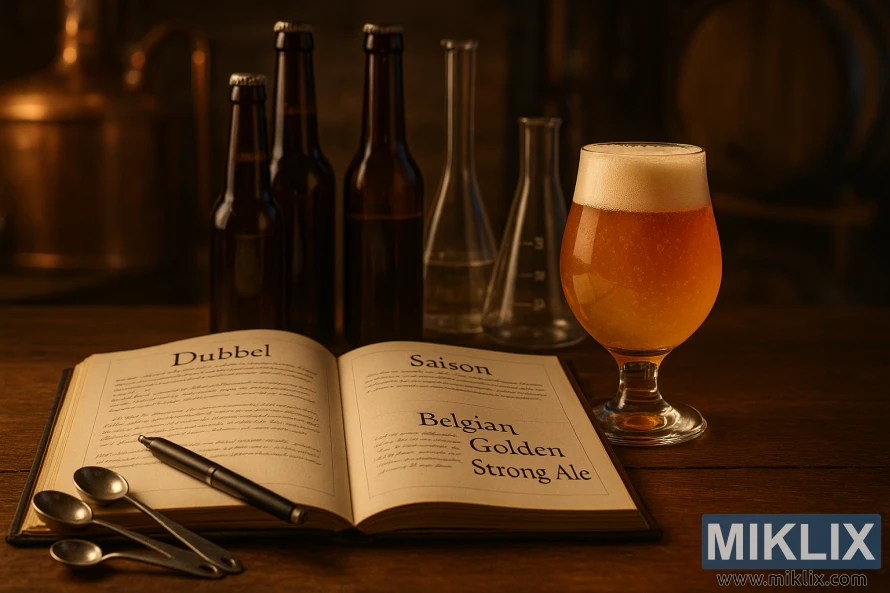Image: Belgian Beer Recipe Book and Tripel
Published: October 4, 2025 at 12:22:21 PM UTC
A rustic brewery scene with an open Belgian beer recipe book, a golden Tripel in a tulip glass, and brewing tools bathed in warm light.
The image depicts a warmly lit, rustic brewery setting with a strong artisanal atmosphere, focusing on a recipe book spread open on a sturdy wooden table. The book, aged slightly in appearance with sepia-toned pages and faintly blurred handwriting, is clearly devoted to Belgian beer recipes. Each page is divided into sections, with bold, legible headlines naming specific Belgian beer styles, while the body text below them remains softly blurred, preventing any actual recipes from being read. This artistic choice emphasizes authenticity and the brewer’s craft without giving away exact details, while also lending the book a sense of intimacy and personal history.
On the left-hand page, the upper section bears the heading “Dubbel”, a classic Belgian style known for its malty richness, dark fruit character, and smooth drinkability. Beneath the heading, blurred handwritten notes in dark ink mimic the appearance of carefully recorded brewing steps, water chemistry adjustments, yeast management, and malt bill proportions. The handwriting feels personal, as if written by a brewer who has refined the recipe through years of experimentation.
Just below, still on the left page, is another section titled “Saison.” This style is often rustic, spicy, and effervescent, historically brewed for seasonal farm workers. The blurred text beneath suggests detailed fermentation temperature guidelines and perhaps notes on yeast behavior, reflecting the saison’s dependence on yeast-derived flavor. Together, these two sections on the left page balance tradition and farmhouse character, presenting recipes that embody the variety of Belgian brewing.
On the right-hand page, two recipes stand out. At the top of the page is “Belgian Tripel,” a golden, high-alcohol ale prized for its blend of fruity esters, spicy phenols, and dry, highly carbonated finish. The blurred text below hints at the precision needed to achieve balance in such a powerful beer, with notes on sugar additions, fermentation profiles, and timing. This recipe’s placement near the top signals its importance as one of the cornerstones of Belgian brewing heritage.
Beneath it, completing the spread, is “Belgian Golden Strong Ale.” This headline replaces the earlier, misspelled “Goden” from previous iterations, now presented in clear, elegant type. This style, famously championed by Belgian brewers as a rival to European pale lagers, is known for its deceptively light body, bright fruitiness, and strong alcohol content cloaked in drinkability. The blurred handwriting below the title implies technical notes—mash temperatures, yeast nutrient additions, carbonation methods—that are critical for producing the beer’s clean yet expressive profile.
A glass of golden Belgian Tripel rests to the right of the open book, filled nearly to the rim with effervescent, golden-amber liquid crowned by a fluffy, persistent head of foam. Tiny bubbles rise through the body of the beer, catching the glow of the ambient light. The tulip-shaped glass enhances the beer’s rich color and sparkle, while the lettering “BELGIAN TRIPEL” on the glass further ties the drink to the recipes within the book. The proximity of the beer to the open pages suggests that the recipes are not just theoretical—they have been brewed, tasted, and celebrated.
Beside the book, a set of metal measuring spoons lies neatly stacked, symbolizing the scientific precision required in brewing. A pen rests on the page labeled “Dubbel,” as if the brewer has just finished recording adjustments or is preparing to refine the recipe further. These small details emphasize brewing as a blend of artistry and meticulous record-keeping.
In the background, the brewery setting deepens the atmosphere. Amber-colored bottles, some with labels, stand in a small cluster. Glass labware—graduated cylinders and Erlenmeyer flasks—reinforce the sense of brewing as both art and science, where yeast starters, gravities, and careful measurements play a vital role. Beyond them, blurred copper kettles and faintly visible wooden barrels anchor the scene in tradition. The copper gleams warmly even in shadow, while the oak barrels, round and dark, suggest storage, aging, and patience.
The overall lighting is golden and inviting, casting warm highlights on the beer, the metal utensils, and the book’s parchment-like pages. Shadows are soft, adding depth without harshness, creating a cozy, contemplative mood. The composition balances foreground detail with atmospheric background hints, guiding the eye from the book and glass outward into the broader context of the brewery.
Together, these elements create an image that embodies the craft of brewing Belgian beer: precision and artistry, science and tradition, inspiration and execution. The recipe book, glass of beer, and tools form a tableau that celebrates both heritage and innovation, inviting the viewer into the intimate world of a brewer who not only records recipes but brings them vividly to life.
The image is related to: Fermenting Beer with Wyeast 1388 Belgian Strong Ale Yeast

